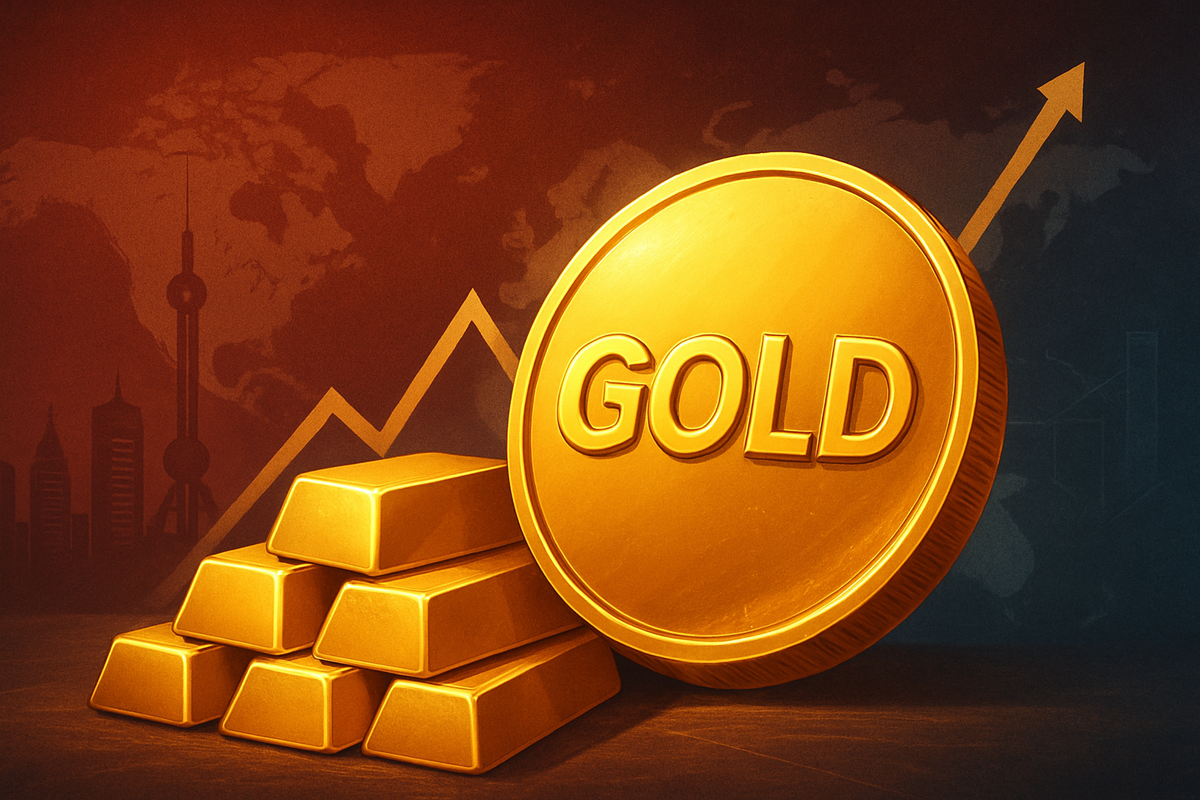
China's gold market has exhibited an unseasonable surge in strength throughout October and into early November 2025, according to the World Gold Council (WGC). This robust demand, particularly from investment and central bank sectors, is defying traditional seasonal slowdowns and is poised to exert significant upward pressure on global gold prices. The unexpected vigor in the world's largest gold consumer nation highlights a deepening investor appetite for safe-haven assets amidst a backdrop of economic uncertainty and geopolitical tensions.
This unusual market activity signals a pivotal shift in gold's role within the Chinese financial landscape, moving beyond traditional jewelry consumption towards a more pronounced investment and strategic reserve function. As global markets grapple with inflation concerns and fluctuating economic indicators, China's sustained demand acts as a powerful bullish signal for the precious metal, prompting analysts to re-evaluate near-term price forecasts and long-term market dynamics.
Unpacking the Golden Surge: Drivers and Market Reactions
The unseasonable strength witnessed in China's gold market during October and early November 2025 was a multi-faceted phenomenon, primarily driven by robust investment inflows and consistent central bank accumulation. Contrary to typical seasonal trends, where wholesale gold demand often cools, October saw increases in both monthly and yearly terms. This momentum carried into the first half of November, with gold prices bouncing higher. The Shanghai Benchmark Gold Price PM (SHAUPM) in RMB concluded October with positive gains, extending its impressive year-to-date growth to 42%.
A significant contributor to this surge was the substantial interest from Chinese investors in gold Exchange Traded Funds (ETFs). October recorded substantial inflows of RMB 32 billion (US$4.5 billion) into these ETFs, marking their strongest performance since April and pushing total assets under management to a new month-end peak. Concurrently, gold futures trading on the Shanghai Futures Exchange (SHFE) experienced a sharp increase in activity, underscoring heightened speculative and hedging interest. This investment drive is largely fueled by expectations of further price appreciation, juxtaposed against ongoing domestic economic uncertainties. Adding to this formidable demand, the People's Bank of China (PBoC) continued its relentless gold purchasing spree, marking its twelfth consecutive monthly addition to its gold reserves in October 2025. This consistent accumulation is a cornerstone of China's broader strategy to diversify its reserves away from dollar-denominated assets, a trend that has significantly bolstered gold prices globally over recent years. Geopolitical risks and uncertainties, which saw an initial spike in October, also played a crucial role, reinforcing gold's enduring appeal as a safe-haven asset amidst global instability and slowing economic growth. Domestically, the subdued performance of local stock markets and a struggling property sector have further prompted Chinese investors to reallocate capital towards gold, enhancing its appeal as an alternative investment. A depreciating RMB has also contributed to the rise in RMB gold prices.
However, it's important to note a divergence: while investment demand soared, the demand for gold jewelry in China faced headwinds. High gold prices led to an 18% decline in jewelry purchases in Q3 2025 compared to the previous year, marking the weakest third quarter since 2007. A newly implemented value-added tax (VAT) on physical gold, effective November 1, 2025, further impacted jewelry manufacturers and retailers, though it notably does not apply to gold bars sold by Shanghai Gold Exchange (SGE) members or gold ETFs, thereby implicitly supporting investment demand. The immediate global market reaction has been characterized by upward price pressure and increased volatility. China's consistent buying has been a primary driver of the significant increase in global gold prices over the past three years. While prices initially soared in October, they later cooled slightly due to easing geopolitical concerns and profit-taking, before bouncing higher in early November. This volatility underscores the market's sensitivity to both demand-side pressures from key players like China and broader macroeconomic and geopolitical shifts.
Corporate Fortunes in the Golden Tide: Winners and Watch-Outs
The unprecedented strength in China's gold market during October and early November 2025 has created a distinct cleavage in corporate fortunes, directly benefiting companies deeply entrenched in gold mining, refining, and specialized financial products, while potentially posing challenges for broader equity-focused funds. As global gold prices continue their upward trajectory, buoyed by Chinese demand, the landscape for these entities is being significantly reshaped.
Gold Mining Companies stand out as the primary beneficiaries. Higher gold prices directly translate into increased revenues and expanded profit margins for miners, especially those with efficient operations. Global giants like Barrick Gold Corporation (NYSE: GOLD) and Newmont Corporation (NYSE: NEM) are poised to see enhanced profitability, improved cash flows, and potentially higher shareholder returns. Similarly, major Chinese gold miners, including Zijin Mining Group Co. Ltd. (SSE: 601899, SEHK: 2899) and Shandong Gold Mining Co. Ltd. (SSE: 600547, SEHK: 1787), are experiencing a dual tailwind: higher global prices and potentially increased domestic demand for physical gold products. Their extensive operations and active capital raising initiatives in 2025 underscore strong investor confidence in the sector. These companies benefit from operational leverage, where their fixed costs remain relatively stable while revenue surges with rising gold prices, leading to outperformance compared to physical gold itself.
Gold Refiners, particularly those in China, are also significant winners. China already commands approximately 80% of global gold refining capacity, and the surge in demand for physical gold for investment purposes means increased throughput for these facilities. While many Chinese refiners are privately held or part of larger state-owned enterprises, the sector as a whole is experiencing higher volumes and potentially stronger margins as they process raw gold into various products. This solidifies China's strategic importance in the global gold supply chain as trading shifts eastward.
In the Financial Sector, Chinese gold Exchange Traded Funds (ETFs) are experiencing a boom. Funds like the Hua An Yifu Gold ETF and Bosera Gold ETF, the largest in China, have seen massive inflows, directly boosting their assets under management (AUM) and consequently, their management fee income. This growth in AUM attracts more investors, further solidifying their market position. Similarly, major Chinese Commercial Banks such as China Citic Bank, China Construction Bank, Bank of China, and Industrial and Commercial Bank of China are benefiting from increased retail and institutional interest in gold accumulation plans and other gold products. While some have raised minimum investment requirements due to volatility, the overall engagement with gold products translates to higher transaction volumes and broader customer engagement. Globally, investment banks with strong precious metals desks, including Goldman Sachs (NYSE: GS) and JPMorgan Chase & Co. (NYSE: JPM), are also seeing increased trading revenue and advisory fees as clients navigate the volatile yet lucrative gold market.
Conversely, some entities might face headwinds. Broader China Equity ETFs, such as the Invesco Golden Dragon China ETF (NASDAQ: PGJ), could experience outflows or underperformance. The significant capital flowing into gold ETFs in China is, in part, being redirected from domestic equity markets, particularly small and mid-cap growth stocks. This reallocation of investor capital away from equities towards safe-haven gold could lead to a decrease in AUM and associated fee income for these broader equity funds. While Chinese banks are overall beneficiaries, the rapid price fluctuations have prompted them to raise minimum investment requirements for gold accumulation plans, which might temper the pace of growth in these specific retail offerings, though it doesn't imply an overall loss given their diverse involvement in the gold market.
A Golden Bellwether: Wider Significance and Global Implications
China's unseasonable gold market strength in October and early November 2025 transcends a mere market anomaly; it is a potent bellwether reflecting profound shifts in global finance, geopolitical strategy, and investor psychology. This surge amplifies well-established trends, pointing towards a more multipolar monetary system and a fundamental re-evaluation of asset allocation.
At its core, China's aggressive gold accumulation is a pivotal component of the accelerating global de-dollarization trend. The People's Bank of China (PBoC)'s consistent buying, now extending to its twelfth consecutive month, underscores a strategic imperative to reduce reliance on the U.S. dollar in its foreign exchange reserves. Gold offers a tangible, sovereign store of value, providing a hedge against dollar volatility and potential geopolitical risks, including sanctions. This strategic pivot is mirrored by central banks worldwide, particularly in emerging economies, which are increasingly diversifying their reserves, signaling a structural shift away from a purely dollar-centric financial system towards one where gold retains a more foundational role.
The event also highlights changing investor preferences within China. Amidst a protracted property sector crisis, volatile domestic stock markets, and a weakening yuan, Chinese investors—both retail and institutional—have increasingly favored gold as a safe-haven asset. Gold is perceived as being immune to local disruptions, lacking counterparty risk, and insulated from direct government intervention. This cautious pragmatism is evident even among younger Chinese consumers, who are reportedly buying small gold "beans" as a savings strategy. This domestic shift, combined with global institutional investors increasing gold allocations due to persistent inflation and geopolitical uncertainty, signifies a broader re-rating of gold as a core asset.
The ripple effects of China's robust gold demand extend across various markets. A strong gold market often signals a broader sentiment shift towards other precious metals. If gold demand remains sustained, it could spur increased interest and investment in silver, platinum, and palladium as investors seek alternatives or follow the safe-haven trend. In currency markets, China's strategic gold buying directly impacts the U.S. dollar by potentially reducing its holdings of U.S. Treasury securities, contributing to long-term downward pressure on the dollar and fostering a more balanced global monetary system. Concurrently, it aims to stabilize and strengthen the yuan's exchange rate. While gold is unique, its strong performance amidst global tensions and inflation concerns can also have spillover effects into other commodity markets, signaling a general flight to hard assets.
From a regulatory and policy perspective, China is actively shaping its gold market infrastructure. The PBoC has proposed significant regulatory changes to streamline gold imports and exports, including expanding "multi-use permits" and simplifying approval processes. These reforms aim to manage gold flows more efficiently, facilitating accumulation and distribution within China's financial system, aligning with de-dollarization objectives. Furthermore, new VAT rules effective November 1, 2025, while impacting jewelry costs, are expected to strengthen investment demand for gold bars and coins, as these directly purchased from Shanghai Gold Exchange (SGE) members face no additional tax burden. Internationally, the collective pivot of central banks towards gold underscores growing concerns over reliance on the U.S. dollar and the weaponization of currency systems, leading to a profound transformation of the global monetary architecture.
Historically, this period of intense central bank and retail gold buying draws comparisons to significant shifts in global monetary history. Central banks have been net buyers of gold since 2009, with purchases dramatically ramping up to over 1,000 tonnes annually in recent years, largely attributed to geopolitical instability following events like Russia's invasion of Ukraine in 2022. Some analysts suggest this structural shift is the most significant transformation of the global monetary system since the Nixon Shock of 1971, when the U.S. ended the dollar's convertibility to gold. This ongoing trend suggests a slow but historic move away from a purely dollar-based financial system, with gold potentially regaining a more dominant role as a fundamental store of value, reminiscent of the 1950s when gold constituted over 70% of global reserves.
The Golden Horizon: What Comes Next for China and Global Gold
The unseasonable strength in China's gold market during October and early November 2025 appears not as an isolated event, but as a precursor to a sustained and dynamic period for both the domestic and global gold landscape. With gold prices having reached unprecedented highs, market participants are now bracing for a future shaped by continued geopolitical shifts, evolving monetary policies, and a structural re-evaluation of reserve assets.
In the short-term (late 2025 - early 2026), while some consolidation due to profit-taking and technical overbought conditions is anticipated, analysts expect any pullbacks to be shallow. "Dip buying" from central banks and other physical buyers is likely to provide strong support, limiting downside risks. The expectation of Federal Reserve interest rate cuts in December 2025 or early 2026 remains a key bullish driver, as it typically weakens the U.S. dollar and reduces the opportunity cost of holding non-yielding gold. Persistent geopolitical tensions and U.S. policy uncertainty will also continue to bolster safe-haven demand. For China's domestic market, the new Value-Added Tax (VAT) rules effective November 1, 2025, are expected to shift consumer behavior from gold jewelry towards investment products like bars and coins, which now face a lower tax burden. Overall investment demand in China is projected to strengthen into 2026, supported by continued price appreciation expectations and the People's Bank of China's (PBoC) consistent acquisitions.
Looking to the long-term (2026 and beyond), the outlook for global gold prices is overwhelmingly bullish. Major financial institutions, including Goldman Sachs (NYSE: GS), J.P. Morgan (NYSE: JPM), and Deutsche Bank, forecast gold prices ranging from $4,000 to over $5,000 per ounce by mid-2026 or year-end 2026. This sustained appreciation will be driven by continued strong central bank purchases—particularly by the PBoC, which is expected to methodically accumulate reserves exceeding 2,150 tonnes as part of its de-dollarization strategy—a weaker U.S. dollar, lower real interest rates, and persistent macroeconomic uncertainty. China's strategic role will further expand through initiatives like the "Gold Corridor," a network of BRICS-linked vaults and settlement systems facilitating the exchange of yuan for physical gold, a cornerstone of its strategy to build a parallel financial system.
Strategic pivots will be essential for market participants. For investors, gold remains a crucial portfolio diversifier and hedge; financial advisors suggest allocating 5-10% to precious metals, employing dollar-cost averaging, and maintaining a long-term view. The Chinese jewelry market will need to innovate to counter increased costs from new VAT rules, likely accelerating the consumer shift towards investment-grade gold products. Gold miners, while benefiting from higher prices, are unlikely to see a "super-cycle" of new capital investments due to ongoing challenges like permitting, instead focusing on expanding existing mines.
Emerging market opportunities include central banks in these regions, which are significantly underweight gold and actively increasing their allocations as part of broader diversification strategies. Opportunistic household demand in countries with strong cultural ties to gold, like India, will also continue to provide a price floor. However, challenges include price sensitivity among emerging market consumers and potential impacts from weaker global growth.
Several potential scenarios could unfold. The base case remains bullish, with continued strong central bank demand, a moderately weakening U.S. dollar, and steady private investor interest pushing prices towards and potentially beyond $4,000. An ultra-bullish stress scenario could see a severe crisis of confidence in the Federal Reserve, a significant geopolitical escalation, or acute financial instability, triggering a "rush to gold" that could push prices well above $5,000. Conversely, bearish risks include an unexpected strengthening of the U.S. dollar, a more hawkish Federal Reserve policy, significant geopolitical de-escalation reducing safe-haven demand, or demand destruction if prices climb too steeply.
The Golden Age: A Comprehensive Wrap-up and Forward Look
The unseasonable strength of China's gold market in October and early November 2025 stands as a landmark event, underscoring a profound and lasting shift in global financial dynamics. This period of robust demand, primarily driven by strategic central bank accumulation and burgeoning investment interest from Chinese citizens, has not only defied seasonal norms but has also solidified gold's position as a critical asset in an increasingly uncertain world.
Key takeaways from this event are multifaceted. Firstly, China's consistent gold buying, particularly by the People's Bank of China (PBoC), is a clear manifestation of a deliberate de-dollarization strategy, aiming to diversify national reserves and enhance monetary sovereignty. Secondly, domestic economic uncertainties—including a struggling property market and volatile equities—has propelled Chinese retail and institutional investors towards gold as a trusted safe haven, fundamentally altering local investment preferences. Thirdly, the global geopolitical landscape continues to fuel gold's appeal as a hedge against instability, reinforcing its traditional role as a crisis commodity. Finally, new regulatory frameworks, such as the revised VAT rules, are strategically redirecting internal demand from jewelry towards investment-grade physical gold, further embedding its financial significance within China.
Moving forward, the gold market is poised for continued bullish momentum. While short-term volatility and profit-taking may occur, the underlying structural drivers suggest these will be shallow corrections. The pervasive expectation of Federal Reserve interest rate cuts, a potentially weaker U.S. dollar, and sustained central bank demand worldwide are powerful tailwinds. China will remain a pivotal player, not only through its official gold accumulation but also through the ongoing development of initiatives like the "Gold Corridor," which aims to create a parallel financial system centered on physical gold.
The lasting impact of this event is likely to be a more multipolar global monetary system, where gold plays an increasingly prominent role as a foundational store of value, challenging the long-standing dominance of the U.S. dollar. This shift reflects a collective re-evaluation of risk and a desire for tangible assets that offer protection against geopolitical weaponization of finance and inflationary pressures. The unseasonable strength in China serves as a powerful indicator that this transformation is not merely theoretical but is actively unfolding in real-time market behavior.
Investors should watch for several key indicators in the coming months. Continued monitoring of central bank gold purchasing data, particularly from China and other emerging economies, will be crucial. Developments in U.S. monetary policy, including the timing and extent of Federal Reserve rate adjustments, will significantly influence gold's attractiveness. Furthermore, tracking geopolitical events and their potential to escalate or de-escalate will remain vital for gauging safe-haven demand. Domestically in China, observing the impact of the new VAT rules on consumer behavior and the growth of gold ETFs will provide insights into the evolving investment landscape. Ultimately, the golden tide from China signals a profound and enduring shift, one that prudent investors should carefully navigate as the global financial architecture continues to evolve.
This content is intended for informational purposes only and is not financial advice






